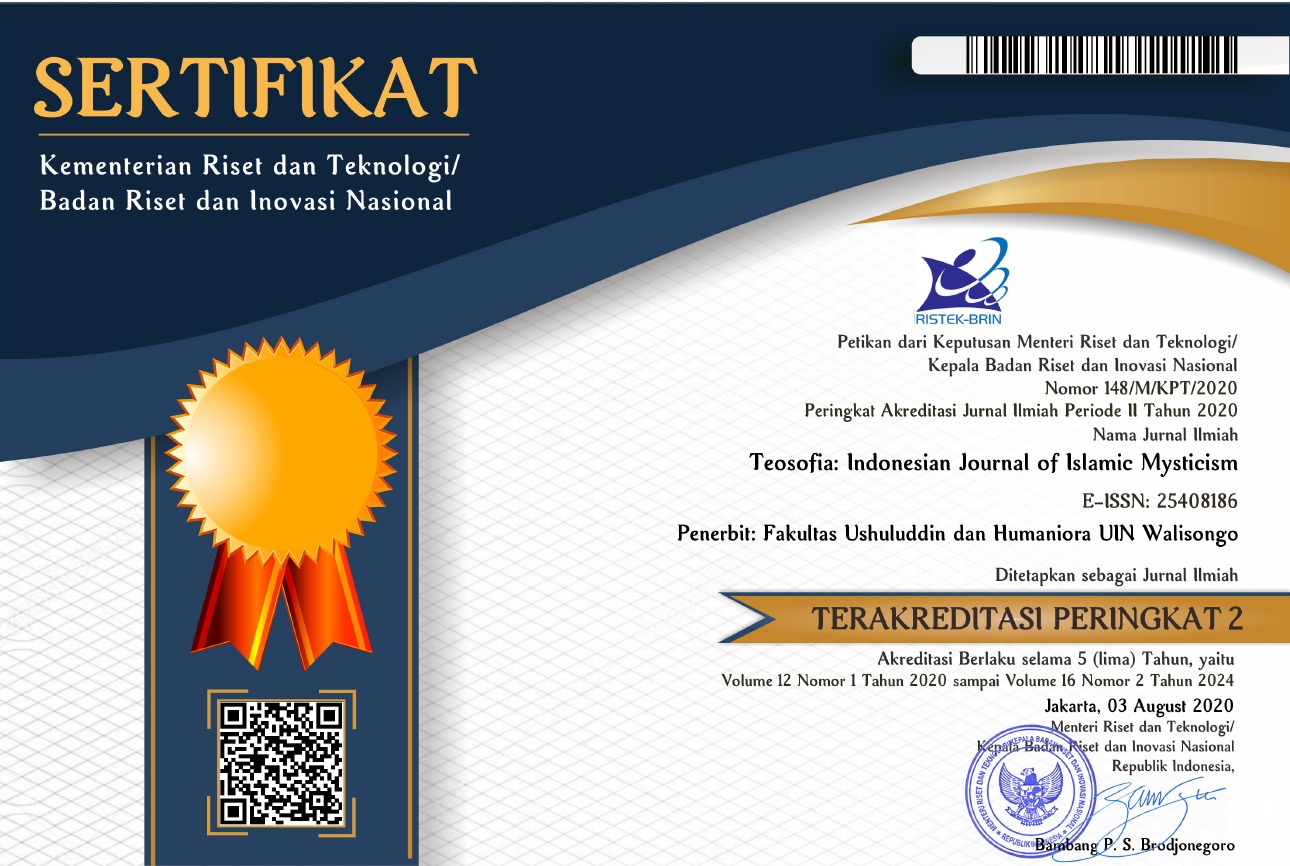Taking the Mystical Ways toward Allah: Kyai Sholeh Darat Al-Samarani’s Perspective
DOI:
https://doi.org/10.21580/tos.v12i2.14654Keywords:
sufism, suluk, syariah, tarekat, hakikah, bayani, irfaniAbstract
For a servant, taking the mystical way to get closer to Allah is necessary to achieve perfection in this world and the hereafter. This study aims to reveal the mystical ways towards Allah from the perspective of Kyai Sholeh Darat, especially as elaborated in his book Minhāj al-Atqiyā' ilā Ma’rifati Hidāyat al-Adhkiyā' ilā Ṭarīqat al-Auliyā'. This study is qualitative-based research with a descriptive approach. The data were collected from library research. The data were then analysed using the Mile and Huberman analysis. The findings of this study reveal that 1) Kyai Sholeh Darat's book uses references from the Quran, hadith, and the trusted religious texts written by the taṣawwuf scholars; 2) the mystical way or sulūk that a spiritual traveller (sālik) undergoes to get ma'rifatullāh must go through sharī'a, ṭarīqa and ḥaqīqa; and 3) the methods used by Kyai Sholeh Darat in his book are bayānī and irfānī.
Contribution: This study affirms that suluk to Allah must go through three paths, namely sharī'a, ṭarīqa and ḥaqīqa. Those three paths cannot be split from one another as there have been movements in which these three aspects are considered separated. For example, to pursue ḥaqīqa, the one only needs ṭarīqa without sharī'a, etc.
Downloads
References
Al-Ajiba, Syekh Ahmad bin Muhammad. Iqadz Al Himam Bi Syarh Hikam Syekh Ahmad Bin Muhammad Ibnu ‘Ataillah As-Sakandari. Beirut, n.d.
Al-Baghdadi, Ibnu Nushair. Al-Fawayd Wa Al-Zuhd Wa Al-Raqa’iq Wa Al-Marathi. Jeddah: Dar al-Sahabah li al-Turath, 1989.
Al-Hakim, Imam. Al-Mustadrak. Vol. 1. Beirut: Daar al Kutub al-Ilmiyah, 2010.
Al-Jawi, Syeikh Muhammad Nawawi al-Bantani. Tafsir Al-Munir Marah Labid. Translated by Bahrun Abu Bakar. Bandung: Sinar Baru Algensindo, 2013.
Al-Randî, Muhammad ibn Ibrâhîm. Syarh Al-Hikam. Singapore, n.d.
Al-Sakhawi, Muhammad. Takhrij Al-Arba’in Al-Sulamiyyah Fi Al-Tasawwuf. Beirut: al-Maktab al-Islami, 1988.
Al-Walid, Khalid. Tasawuf Mulla Sadra. Bandung: Muthahhari Press, 2005.
An-Nawawi, Imam Muhyiddin Abu Zakariyah. Al-Minhāj Syarh Shahih Muslim Bin Al-Hajjaj. Beirut: Darul Ma’rifah, n.d.
———. Syarah Hadist Al Arba’ an Nawawiyah. Beirut: Darul Minhāj, 2005.
Arberry, Arthur John. Sufism: An Account of the Mystics of Islam. Leiden: E.J. Brill, 1979.
As-Suyuthi, Imam Jalaluddin. Al-Arba’una Hadithan Fi Qawa’id Al-Ahkam Al-Shar’iyyah Wa Fadail Al-A’mal Wa Al-Zuhd. Jeddah: Dar al-Manarah, 1997.
Bakri, Syamsul. Akhlak Tasawuf: Dimensi Spiritual Dalam Kesejarahan Islam. Surakarta: EFUDEPRESS, 2005.
Bogdan, Robert C., and Sari Knopp Biklen. Qualitative Research for Education: An Introduction to Theory and Methods. 3rd ed. Boston: Allyn and Bacon, 1998.
Chamami, M Rikza, Abdurrahman Mas’ud, and Ruswan. “Educating The Heart: The Concept of Qalb Education in Minhāju Al-Atqiyā’i Fi Syarḥi Ma’rifati Al-Ażkiyā’i Ilā Ṭarīqi Al-Auliyā’i by KH. Sholeh Darat.” Nadwa: Jurnal Pendidikan Islam 15, no. 2 (2021): 129–48. https://doi.org/10.21580/nw.2021.15.2.9372.
Fa’atin, Salmah, and Aba Agil Aziz. “Konsep Character Education Perspektif Turats Sufi Lokal Sabilul Abid Syarah Jauharah Al-Tauhid Karya Sholeh Darat.” In EAIC: Esoterik Annual International Conferences, 253–72. Kudus: Tasawuf and Psychotherapy Department, Ushuluddin Faculty, Islamic State Institute of Kudus, 2022. https://proceeding.iainkudus.ac.id/index.php/EAIC/article/view/312.
Farid, Ahmad. Al-Bahr Al-Ra’iq Fi Al-Zuhd Wa Al-Raqa’iq. Jeddah: Maktabah al-Shahabah, 1991.
Farida, Meutia. “Perkembangan Pemikiran Tasawuf Dan Implementasinya Di Era Modern.” Substantia 13, no. 1 (2011): 105–14. https://doi.org/10.22373/substantia.v13i1.4816.
Hadikusuma, Wira. “Epistemologi Bayani, Irfani Dan Burhani Al-Jabiri Dan Relevansinya Bagi Studi Agama Untuk Resolusi Konflik Dan Peacebuilding.” Jurnal Ilmiah Syi’ar 18, no. 1 (January 2, 2018): 1–19. https://doi.org/10.29300/syr.v18i1.1510.
Hafiun, Muhammad. “Teori Asal Usul Tasawuf.” Jurnal Dakwah: Media Komunikasi Dan Dakwah 13, no. 2 (2012): 241–253. https://doi.org/10.14421/jd.2012.13206.
Hasani, Alhabib Zain bin Ibrahim bin Sumait ba Alwi al. Syarhu Hadits Jibril. Bogor: Daarul Ilmi, 2006.
M. Rofiq. “Sufisme KH. Shaleh Darat Terhadap Penafsiran Ayat-Ayat Shalat Dalam Tafsir Faid Al-Rahman.” Al Dhikra | Jurnal Studi Qur’an Dan Hadis 2, no. 1 (September 26, 2022): 83–94. https://doi.org/10.57217/aldhikra.v2i1.773.
Mas’ud, Ali. Pemikiran Tasawuf KH. Saleh Darat Al-Samarani: Maha Guru Para Ulama Nusantara. Surabaya: Pustaka Idea, 2018.
Masduqi, Ach. Konsep Dasar Pengertian Ahlus Sunnah Wal Jamaah. Surabaya: Pelita Dunia, 1996.
Miles, Mathew B., and A. Michael Huberman. Qualitative Data Analys. 2nd ed. London: Sage Publication, 1994.
Moleong, Lexy J. Metodologi Penelitian Kualitatif. Bandung: Remaja Rosdakarya, 2010.
Munandar, Siswoyo Aris, and Mursalat. “Konsep Makrifat Dalam Kitab Syarḥ Al-Ḥikam Karya Kyai Sholeh Darat.” TAJDID 28, no. 2 (2021): 255–90. https://doi.org/10.36667/tajdid.v28i2.444.
Nicholson, Reynold A. Mistik Islam: Ajaran Gaib. Jakarta: MM Corporation, 2003.
Qusyairi, Abu al Qosyim abd Al Karim. Ar Risalah. Mesir, 1959.
Simuh. Sufisme Jawa: Transformasi Tasawuf Islam Ke Mistik Jawa. Yogyakarta: Bentang Budaya, 2018.
———. Tasawuf Dan Perkembangannya Dalam Islam. Yogyakarta: IRCiSod, 2019.
Siregar, Rivay A. Tasawuf Dari Sufisme Klasik Ke Neo-Sufisme. Jakarta: RajaGrafindo Persada, 2002.
Syamsuri, Syamsuri. “Memadukan Kembali Eksoterisme Dan Esoterisme Dalam Islam.” MIQOT: Jurnal Ilmu-Ilmu Keislaman 37, no. 2 (April 14, 2013): 290–312. https://doi.org/10.30821/miqot.v37i2.84.
Usman, Asep. “Fenomena Tarekat Di Zaman Now: Telaah Atas Ajaran Dan Amalan TQN Suryalaya.” Dakwah: Jurnal Kajian Dakwah Dan Kemasyarakatan 22, no. 2 (October 2, 2018): 198–216. https://doi.org/10.15408/dakwah.v22i2.12068.
Downloads
Published
How to Cite
Issue
Section
License
Copyright
The copyright of the received article shall be assigned to the journal as the publisher of the journal. The intended copyright includes the right to publish the article in various forms (including reprints). The journal maintains the publishing rights to the published articles. Therefore, the author must submit a statement of the Copyright Transfer Agreement.*)
Licensing

This work is licensed under a Creative Commons Attribution-ShareAlike 4.0 International License.
In line with the license, authors are allowed to share and adapt the material. In addition, the material must be given appropriate credit, provided with a link to the license, and indicated if changes were made. If authors remix, transform or build upon the material, authors must distribute their contributions under the same license as the original.
_______
*) Authors whose articles are accepted for publication will receive confirmation via email and send a Copyright Transfer Agreement.








